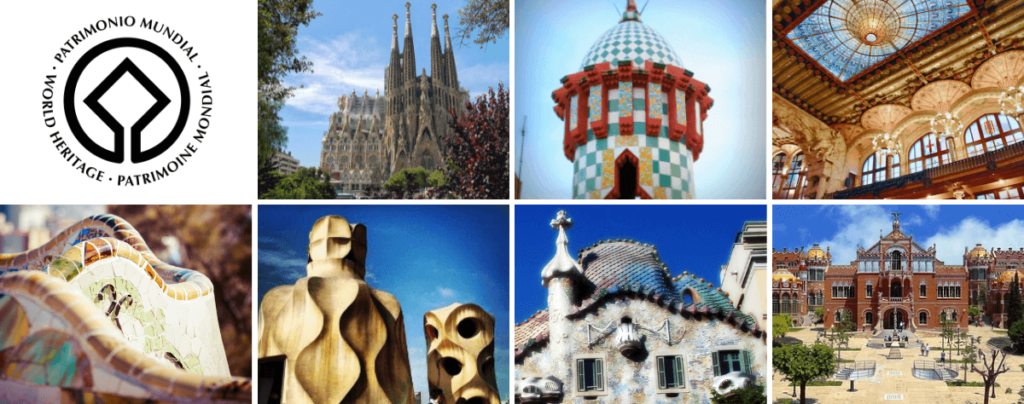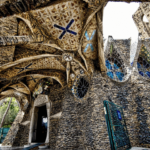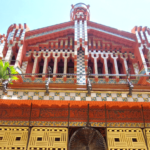All the UNESCO World Heritage sites in Barcelona
ALL THE BARCELONA UNESCO SITES
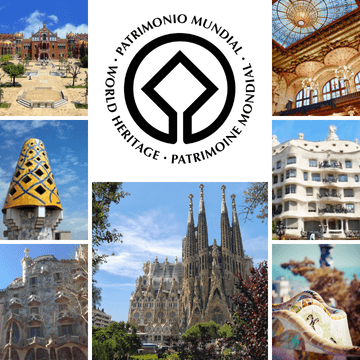
UNESCO stands for United Nations Educational, Scientific and Cultural Organization, and it’s an agency founded in 1945. One of their main projects is the definition and protection of World Heritage Sites – landmarks of world-class cultural or natural interest. As I write this post, Spain features 49 world heritage sites, 11 of them in the region of Catalonia, and 8 of them within the city of Barcelona.
Out of the 9 Barcelona World Heritage sites, 7 of them are architecture works of the architect Antoni Gaudí, and 2 of them were designed by his professor and competitor Domenech i Muntaner. If you are visiting Barcelona, at least some of them should definitely make your list of must-sees. Let us help you decide which ones should be on top of your list!
Barcelona World Heritage sites by Antoni Gaudi
Antoni Gaudi was an architect born in 1852 and died in 1926. His works are a large collection of impressive buildings, urban elements and pieces of furniture, but not all of them have received the World Heritage protection rank. His works in Cantabria and Leon were left out, and didn’t make it either projects such as some small projects outside of Barcelona, or early projects such as Torre Bellesguard, the Teresianes school or Casa Calvet. You can see a complete list of all the Gaudi works in our blog.
In 1984 three Gaudi sites were declared UNESCO SITES, the other four would follow in 2005. From the 7 Works of Antoni Gaudi classed as UNESCO World Heritage, 6 of them in Barcelona city, and one just 30 minutes drive outside of it. Here they are:
1
Park Guell
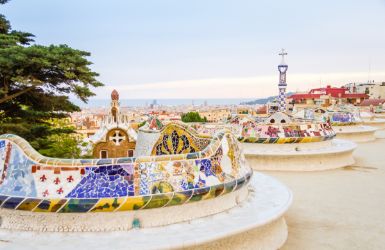
Park Guell is one of the top Gaudi sites in Barcelona. Commissioned by Gaudi's best friend and patron, the Count Eusebi Guell, it was meant to be an exclusive residential area in the fashion of the European "garden cities". The project, though, was an economic failure, and eventually it became a public garden. Its fairy-tale shapes and colorful mosaics make it a park like no other you've seen before.
YEAR OF CONSTRUCTION: 1900-1914
UNESCO SITE SINCE: 1984.
CURRENT USES: Public garden (free for the neighbors, but paid for visitors).
ADDRESS: C/ Olot s/n, 08024 Barcelona (Spain). One of its buildings is a public school, another is a Gaudi Museum, the third is a private residence.
Learn more about Park Guell >>
2
Casa Mila (La Pedrera)
YEAR OF CONSTRUCTION: 1906-1912
UNESCO SITE SINCE: 1984.
CURRENT USES: Partly offices, partly open to the public, one apartment is still residential.
ADDRESS: Passeig de Gracia, 92, 08008 Barcelona (Spain)
Learn more about Casa Mila >>
3
Palau Guell
YEAR OF CONSTRUCTION: 1888
UNESCO SITE SINCE: 1984.
CURRENT USES: Open to the public.
ADDRESS: C/Nou de la Rambla, 3-5, 08001 Barcelona (Spain)
Learn more about Palau Guell >>
4
Sagrada Familia Church (but not the whole building yet!)
Another important thing to take into account is that in order to qualify it needs to be a completed piece, and the rest of Sagrada Familia wasn’t completed by the time the church became a Barcelona World Heritage Site. Who knows if in the future, one the building it’s finished, it could be nominated?
YEAR OF CONSTRUCTION OF THE CRYPT: 1882-1885
YEAR OF CONSTRUCTION OF THE NATIVITY FAÇADE: 1891-1926
UNESCO SITE SINCE: 2005.
CURRENT USES: The crypt functions as a Catholic church, and the Nativity Façade is open to the public as part of the visit of the Sagrada Familia.
ADDRESS: C/ de Mallorca, 401, 08013 Barcelona (Spain)
Learn more about Sagrada Familia >>
5
Casa Batllo
YEAR OF CONSTRUCTION: 1904-1905
UNESCO SITE SINCE: 2005.
CURRENT USES: Partly offices, partly open to the public.
ADDRESS: Passeig de Gracia, 43, 08007 Barcelona (Spain)
Learn more about Casa Batllo >>
6
Casa Vicens
In 1925, its new owner Antoni Jover had a colleague of Gaudi add an extension to the house, and through the years what originally was a single-family holiday house was divided in separate apartments, as a large portion of the gardens were sold and lost. But in 2014 a bank from Andorra purchased the building, made a very comprehensive restoration and finally opened it to the public.
YEAR OF CONSTRUCTION: 1883-85
UNESCO SITE SINCE: 2005.
CURRENT USES: Open to the public.
ADDRESS: c/Carolines, 20-26, 08012 Barcelona (Spain)
Learn more about Casa Vicens >>
7
CrIpta Guell
YEAR OF CONSTRUCTION: 1898 -1914
UNESCO SITE SINCE: 2005.
CURRENT USES: Catholic church open to the public outside of mass hours.
ADDRESS: C/Claudi Güell, 08690 Santa Coloma de Cervelló, Barcelona (Spain)
Learn more about Cripta Guell >>
Barcelona Unesco World Heritage sites by Domenech i Muntaner
Lluís Domenech i Muntaner was the leader of Modernism in Barcelona. Two of his projects, the Castell dels Tres Dragons in the Ciutadella Park and the Muntaner Publishing House, are considered the two first modernist buildings in Barcelona. He was a professor of the Architecture School of the University of Barcelona, first a teacher of Gaudi and later on a competitor. In his works, sculpture, stained-glass and mosaics are combined to achieve a voluptous beauty. Two of his masterpieces were declared World Heritage by UNESCO in 1997.
8
Palau de la Música Catalana
YEAR OF CONSTRUCTION: 1905-1908.
UNESCO SITE SINCE: 1997.
CURRENT USES: Concert hall, open to the public for visitors outside of show times.
ADDRESS: C/Palau de la Música, 4-6, 08003 Barcelona (Spain)
Learn more about Palau de la Música >>
9
Hospital de Sant Pau
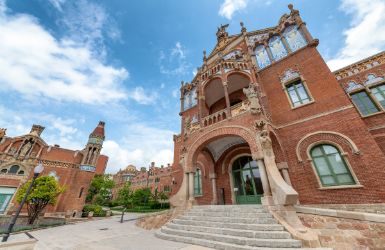
As the medieval hospital facilities in the Old Town of Barcelona were becoming obsolete, the banker Pau Gil promoted the construction of a new hospital in the new Eixample District. Domenech i Muntaner was in charge of the project, and he studied the leading European hospitals to plan his own facility organized in individual pavilions connected by underground tunnels. The hospital services were moved to a new buliding in 2009, and then started its restoration.
YEAR OF CONSTRUCTION: 1898 -1914.
UNESCO SITE SINCE: 1997.
CURRENT USES: Partly open to the public, partly offices, university facilities and research centers.
ADDRESS: C/Sant Antoni Maria Claret, 167, 08025 Barcelona (Spain)
Learn more about the Hospital of Sant Pau >>
Are there any other Unesco sites in Barcelona or its surroundings?
There’s no other UNESCO World Heritage Sites in Barcelona city so far. However, besides the Cripta Guell we discussed before, there’s 4 more World Heritage Sites in Catalonia:
8
Archaeological ensemble of Tarraco
The Tarragona Roman sites protected by UNESCO are the Roman City Walls, the Imperial cult enclosure, the provincial and the colonial forum, the circus, the theatre, the amphitheater and the Paleo-Christian cemetery. The UNESCO sites located in the outskirts of Tarragona are the aqueduct, the tower of Scipios, the Medol quarry, the arch of Barà and the villas of Els Munts and Centcelles.
YEAR OF CONSTRUCTION: II bC – II aC.
UNESCO SITE SINCE: 2000.
CURRENT USES: Open to the public.
ADDRESS: Various locations within and around Tarragona (Spain).
Learn more about Tarragona >>
9
Romanesque Churches of the Vall de Boí
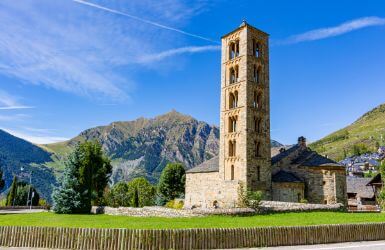
To compensate for the wealth obtained from battling against, the feudal lords of the Pyrenees promoted the construction of many Romanesque churches in the mountain valleys. One of them, the Boi valley, concentrated about a dozen of them, all built pretty much at the same time in very similar styles and were decorated inside with fine Romanesque frescoes. It's considered the largest concentration of Romanesque art in the world.
While the frescoes where stripped out of the churches walls and moved to the MNAC museum for preservation purposes, the conservation of the Romanesque buildings is quite outstanding, and it’s them that the UNESCO has protected. The World Heritage ensemble includes the churches of Sant Joan de Boí, Santa Maria de Taüll, Sant Climent de Taüll, Santa Eulàlia d’Erill-la-Vall, Sant Feliu de Barruera, Nativitat de Durro, l’Assumpció de Santa Maria de Coll, Santa Maria de Cardet and the hermitage of Sant Quirc de Durro. The four first are considered the most remarkable ones.
YEAR OF CONSTRUCTION: XII century.
UNESCO SITE SINCE: 2000.
CURRENT USES: Catholic churches, some of them open to the public outside of mass hours.
ADDRESS: Boí Valley, Pyrenees of Lleida (Spain).
Learn more about the Churches of the Boi Valley>>
10
Poblet Monastery
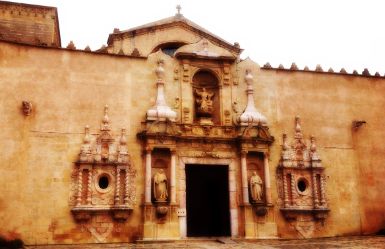
Cistercian monasteries were key in repopulating the South of Catalonia that was reconquered from the moors. Protected by walls as if they were fortresses, the abbots often had as much power as feudal lords, and had connections with the royalty. The monastery of Santa Maria de Poblet is the finest example of them, and it was chosen by several Catalan monarchs as their burial place. Their tombs can be seen in the monastery church.
YEAR OF CONSTRUCTION: XII-XIV centuries.
UNESCO SITE SINCE: 1991.
CURRENT USES: Male monastery, with certain parts open to visitors.
ADDRESS: 43448 Vimbodí, Tarragona (Spain).
Learn more about the best Catalan Monasteries>>
11
Rock Art of the Mediterranean Basin
Finally, the least famous UNESCO World Heritage sites in Catalonia are almost 60 different locations in the provinces of Lleida, Tarragona and Barcelona featuring examples of rock art. Together with other locations along the Spanish Mediterranean coast in Andalucia, Valencia, Murcia as well as in the inland region of Aragon, they constitute a joint World Heritage ensemble.
The rock art in Ulldecona can be visited through the guided tours organized by their local Interpretation Center. Some of the ones in the Prades mountains can also be visited, and an Interpretation Center in Montblanc complements the experience. There’s also an Interpretation Center in La Roca dels Moros del Cogul. As for the other sites, some are managed by the local town council or other local cultural institutions, but many of them aren’t open to the public or are of difficult access.
YEAR OF CREATION: 8000 years ago.
UNESCO SITE SINCE: 1998.
CURRENT USES: Small caves and rock shelters, only a few open to the public.
ADDRESS: Various locations in the provinces of Barcelona, Lleida and Tarragona (Spain).
Learn more about the Catalan rock art >>
Catalonia Intangible Cultural Heritage
Besides natural and cultural sites, the UNESCO is also committed to identify and protect unique cultural forms of expression around the world. Traditions, festivals, ancient crafts… Spain has 23 elements classed as UNESCO Intangible Cultural Heritage. Some of them, such as the Mediterranean Diet, are common to all Spain and sometimes they are shared with other countries. 6 of them are intimately linked to the Catalan culture.
12
Human towers
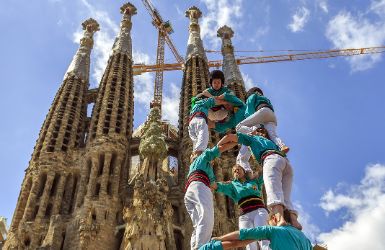
Known in Catalonia as "Castellers", this very Catalan tradition consists in teams of people of different ages, from young children to grown adults, climbing on each other shoulders to build human towers. A band playing traditional music sets the pace of the participants and adds a vibe. There's rules that stablish the different degrees of complexity of each "castle" or tower, competitions between the best teams... They can often be seen during the main Catalan festivals. UNESCO HERITAGE SINCE: 2010. Learn more about Castellers >>
13
Patum of Berga
Patum is the name of the Corpus Christi celebrations that take place in the town of Berga (Barcelona, Spain). It includes religous theater performances, parades with beast sculptures, drummers, and their infamous Patum nights when fire-spitting beasts chase people on the tiny town place to the sound of drums.
UNESCO HERITAGE SINCE: 2008.
Learn more about other Catalan Corpus traditions>>
14
Timber rafting
An Intangible Cultural Heritage shared with other countries such as Poland, Germany, Austria, Czechia and Latvia, in Spain timber rafts are a tradition found in Catalonia and Valencia. They were used to transport wood, people and sometimes a variety of goods through the local rivers. In our land the rafts are called “rais”, and the raftmen are called “raiers”. They continue to be alive in local festivals along the Noguera and Segre rivers, mainly in the villages of Coll de Nargo and Pobla de Segur.
UNESCO HERITAGE SINCE: 2002.
Learn more about Catalan timber rafters>>
15
Summer solstice fire festivals in the Pyrenees
Another shared Intangible Cultural Heritage element shared with other countries, this time with those along the Pyrenees: Andorra and France. In our lands solstice, as the beginning of the Summer and shortest night of the year, is intimately linked to fire: fireworks, bonfires and in the Pyrenees, torch processions of people (traditionally young men) descending the mountains towards their villages, where beacons wait for them to arrive and lit the fires.
UNESCO HERITAGE SINCE: 2015.
Learn more about other Catalan solstice traditions>>
16
Art of dry stone walling, knowledge and techniques
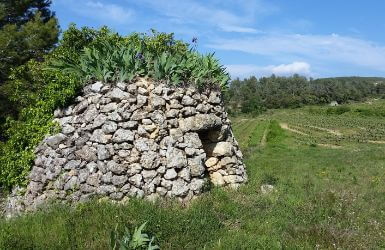
Dry stone is an ancestral building technique used in the countryside and rural areas, wether to stabilize slopes or to build shepperds shelters or even mountain dwellings. One by one, the stones are selected to be placed on top of each other without any cement in between - hence the term "dry". This techniques are common in rural areas of France, Italy, Greece, Cyprus, Croatia, Slovenia, Switzerland and Spain, and they are UNESCO heritage since 2018.
17
Methodology for inventorying intangible cultural heritage in biosphere reserves: the experience of Montseny
And lastly, the Catalan UNESCO Center working in collaboration with the Biosphere Reserve of the Montseny mountain range designed a methodology to identify intangible heritage to contribute to sustainable development and incentivate the local population to participate. Such methodology could be exported to other areas, at regional or international scales, no matter if it was developping countries or lands with an already rich and complex tradition. Such methodology was included in the list of Intangible World Heritage in 2013.
What are your favorite Unesco World Heritage sites in Barcelona?
Marta
RESEARCHING FOR A TRIP IS TIME-CONSUMING…
Need more inspiration?
Our 100% FREE Barcelona Collection will give you everything you need to organize the trip of your lifetime to Barcelona.
BEST INSIDER TIPS FROM THE PROS!


